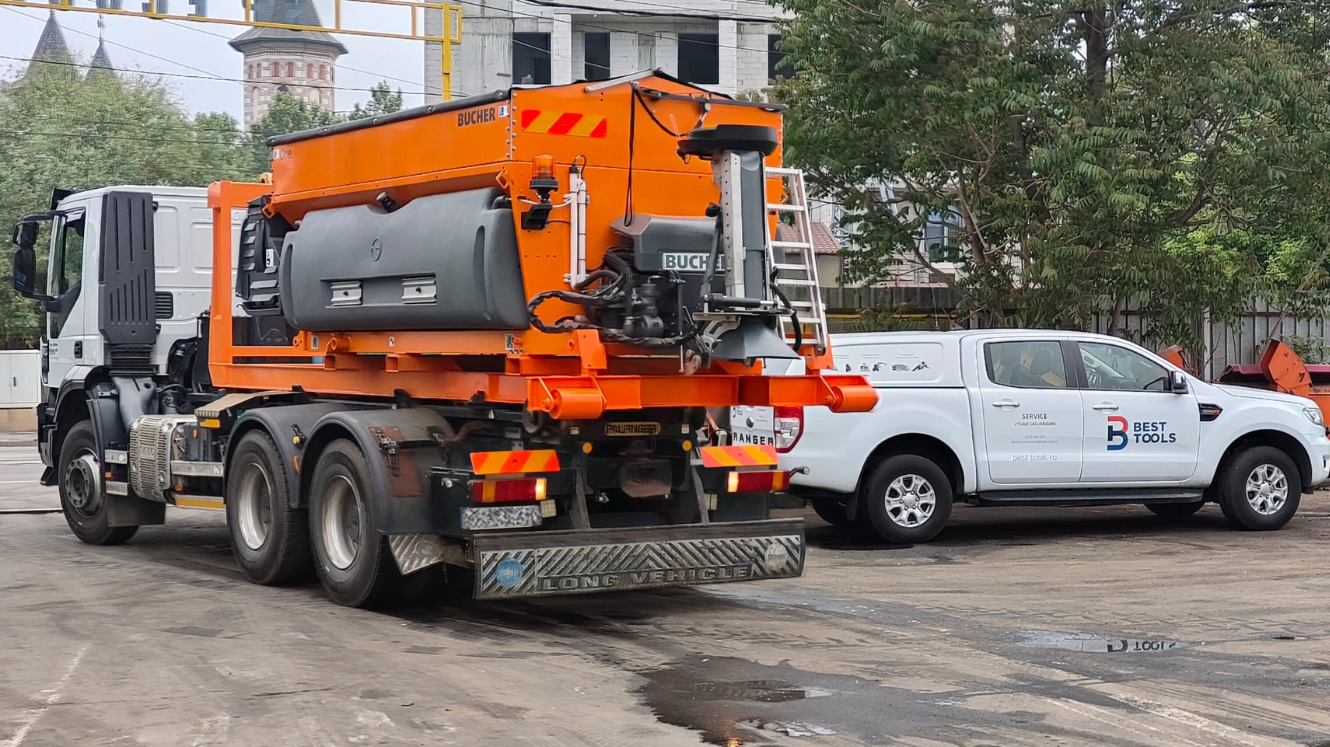Winter doesn’t ask if you’re ready. It just starts.
And that’s when you see the difference between a fleet that was checked in autumn and one that’s „fixed din mers”.
A blocked spreader, a snow plough that won’t lift or a weak chassis are not just technical issues. They mean:
- slippery roads,
- blocked or damaged vehicles,
- complaints from drivers and citizens.
The good news: a proper check before the season starts prevents many of these problems.
- The spreader – the heart of winter service
Conveyor belt or auger
Many issues start here.
- Check the condition of the belt or auger: no cracks, cuts or deformation.
- Make sure there are no bridges or „dead zones” in the hopper where material can get stuck.
- Run the spreader and listen: unusual knocking, squeaking or strong vibration means something is wrong – better fix it now, not during a snowstorm.
- Check the tension of the belt:
- too loose → it slips,
- too tight → it can break.
Spinning disc and liquid system (if fitted)
- Clean the spreading disc and vanes properly. Thick deposits change the spreading pattern.
- Check bolts, bearings and the drive motor for play or loose parts.
- If you are also using brine:
- flush the liquid circuit,
- check that nozzles are not clogged,
- inspect the pump – no leaks, smooth operation.
Cab controller and wiring
Many „mysterious” faults are just bad connections.
- Switch on the system and test all buttons and knobs on the in-cab controller.
- Check cables and connectors between the cab and the spreader – especially where they are exposed to water, salt and vibration.
- Simulate a real job:
- change the spreading rate,
- change spreading width,
- switch liquid on/off (if you have it).
If the equipment has a tracking or data recording system, make sure data is stored and sent correctly – this helps a lot when you need to prove what was done on the road.

- The snow plough – the blade doing the hard work
A plough that is not checked can damage the road, break down or push snow the wrong way.
Wear parts / cutting edges
- Check the cutting edges: how much material is left, are they worn unevenly, are there cracks?
- Make sure all fixing bolts are in place and properly tightened.
- If you work a lot on asphalt, think about changing worn edges in time – to protect both the plough and the road surface.
Lifting and angling
- Lift and lower the plough several times – movements should be smooth, no jerking.
- Angle the plough left–right: it should move freely, without sticking.
- Check hydraulic cylinders, hoses and couplings:
- no leaks,
- no cracked or swollen hoses.
Protection systems
- If the plough has trip springs or sectional blades to protect against obstacles, check that they work correctly.
- A working protection system means fewer damages to both the plough and the truck when you hit manholes, curbs or uneven surfaces.

- Chassis and truck – the base of everything
Even the best plough and spreader won’t help if the chassis has problems.
Mounting points
- Check all mounting points for plough and spreader:
- bolts, brackets, mounting plates,
- no cracks, no movement when working.
- A small play now becomes a big problem when the work gets heavy.
Frame and salt-exposed areas
- Look under the truck, especially where water and salt hit most:
- early signs of rust,
- cracks,
- weakened areas.
- Clean properly and apply anti-corrosion protection where needed.
Truck systems
- Check brakes, steering and electrics of the truck, not just the attachments.
- Make sure all lights, warning beacons and work lights are working – visibility is critical in winter.
- The people operating the equipment
A good machine, used the wrong way, quickly becomes a „problem machine”.
- Make sure every operator knows:
- how to start and stop all systems,
- how to adjust spreading rate and plough position,
- what they must NOT do (for example, maximum speed with plough down).
- Keep user instructions somewhere easy to find (in the cab or in the workshop). They matter a lot during night shifts, when something goes wrong.
- What to do after the winter season
When the season is over, don’t just park the truck „somewhere at the back of the yard”.
- Empty all remaining material from the hopper.
- Wash spreader, plough and chassis thoroughly, including underneath and in hidden areas.
- Empty and flush the brine system, if you have one.
- Write down any faults or observations from the season, so they can be repaired before next winter.
This way, in autumn you don’t start from zero – you start with equipment that is already in good shape.
Why this preparation is worth it
For municipalities, county councils or winter service contractors, preparing snow removal equipment before winter means:
- fewer breakdowns during snow events,
- faster interventions and safer roads,
- better control of salt and material consumption,
- longer lifetime for plough, spreader and truck.
In short: less stress when the first snowstorm hits.
Who can support you
Best Tools Company is the official Bucher Municipal distributor in Romania and provides complete after-sales services – spare parts, service and technical support – anywhere in the country.
